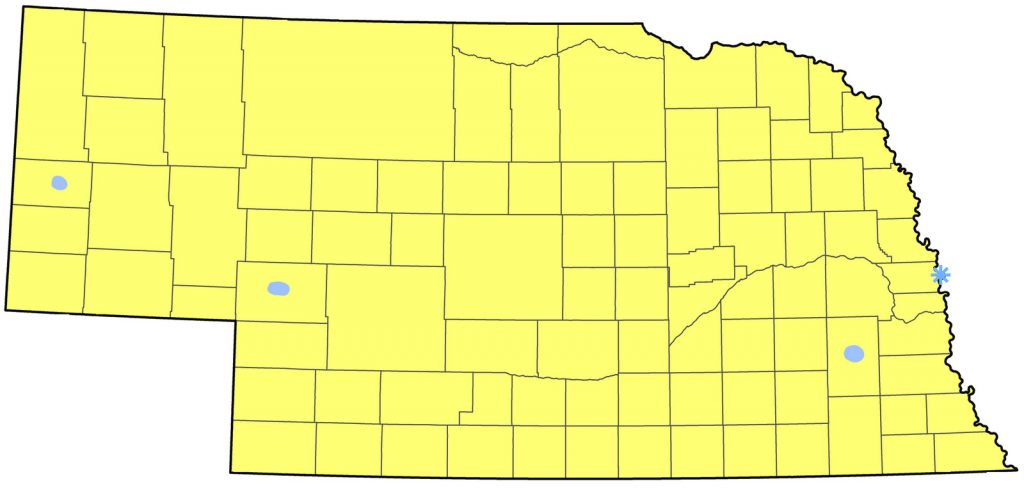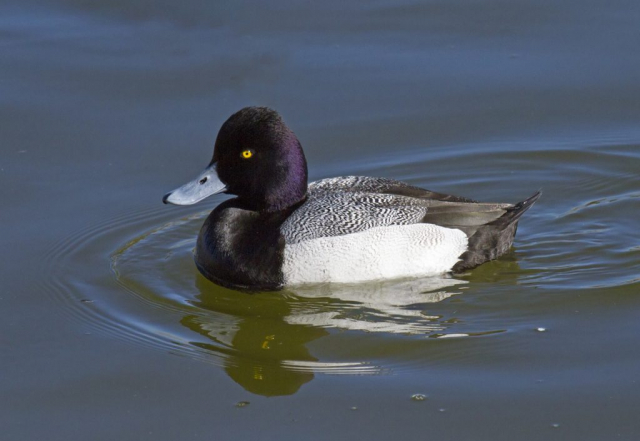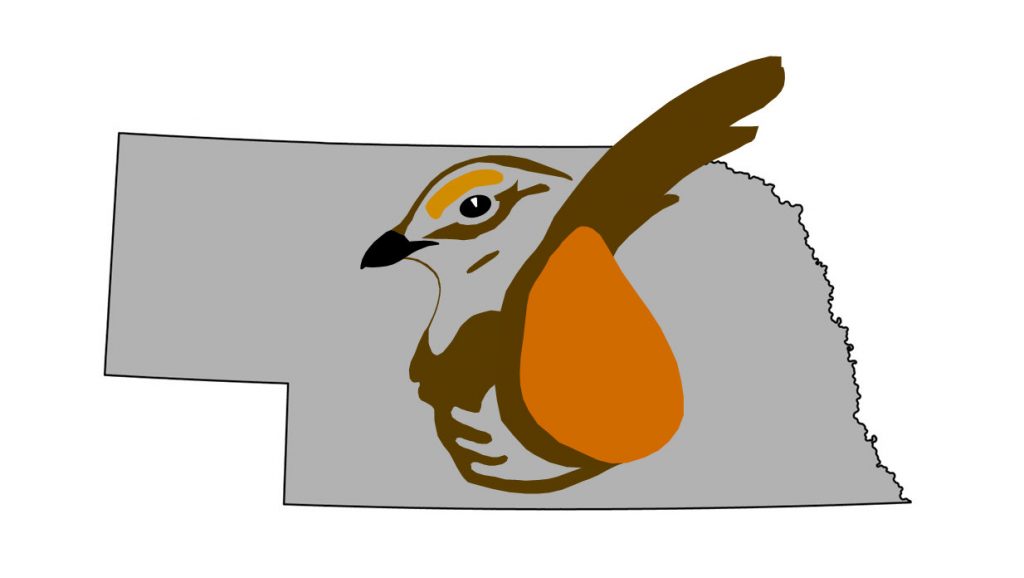Aythya affinis
Status: Common, locally abundant, regular spring and fall migrant statewide. Rare casual summer visitor statewide. Uncommon regular winter visitor west, south, and east, rare casual north.

Documentation: Specimen: UNSM ZM 7679, 11 Apr 1913 Lancaster Co.
Taxonomy: No subspecies are recognized (Gill et al 2022).
For Nebraska records of hybrids see Ring-necked Duck x Lesser Scaup and Tufted Duck x Lesser Scaup.
Changes since 2000: Baldassarre (2014) stated that the total population of Lesser Scaup has “declined markedly” between 1974 and 2009; such a decline, however, has largely gone undetected in Nebraska.
Spring: winter <<<>>> Jun 18, 18, 19
Late dates above are from southern and eastern Nebraska; later dates are listed in Summer.
Arrival occurs as frozen water bodies open with warming temperatures. Peak numbers occur in late Mar and early Apr, and small numbers may persist into late May and early Jun or later (see Summer).
- High counts: 4000 at Lewis and Clark Lake, Knox Co 18 Apr 2023, 3650 in Lancaster Co 25 Mar 2001, 3400 in the eastern Rainwater Basin 17 Mar 2001, 3000 at Gavin’s Point Dam, Cedar Co 23 Mar and 10 Apr 2018, and 3000 at Lake McConaughy, Keith Co 21 Mar 2023.
Summer: There is no conclusive evidence that this species breeds or has bred in Nebraska (Mollhoff 2022); currently the nearest regular breeding is in extreme northeast South Dakota (Tallman et al 2002). See Comments.
There are nevertheless numerous summer reports for the western Sandhills, notably for Garden Co, where there have been counts from Crescent Lake NWR of up to 48 on 16 Jun 1996 and 26 on 17 Jun and 12 Jul 1995; one was there 6 Sep 2012, a male was at Oshkosh SL, Garden Co 2 Sep 1993 (Rosche 1994), and up to five were in the Goose Lake area, Crescent Lake NWR 18 Aug-2 Sep 2020.
There are 28 additional summer (18 Jun-8 Sep) reports in northern and western Nebraska away from Garden Co, including counts of up to 20 at Gering SL, Scotts Bluff Co 24 Jun 1995, eight at Gordon SL, Sheridan Co 8 Jul 1994, and one at Scottsbluff WTP, Scotts Bluff Co 9 Aug 2017.
There are several summer (20 Jun-8 Sep) reports from the Rainwater Basin. Jorgensen (2012) cited 15 eastern Rainwater Basin reports 24 May-7 Aug, including six in the region 28 Jun 2001. More recently, in 2005 up to seven were found in the region through 6 Aug. At Funk WPA, Phelps Co there are reports 22 Jun 1996 and 19 Jul 1997, and there are several summer reports from Adams Co in the 1960s and subsequently, although most recent was 30 Jun 1984.
Elsewhere, away from the Sandhills and Rainwater Basin, there are several summer (20 Jun-8 Sep) reports from Lancaster Co: 6 reports 12 Jun-17 Aug 1992-2006, singles at Holmes Lake 16 Jul 2012, at Branched Oak Lake, Lancaster Co 14 Jun-25 Aug 2017, and 22 Jun-1 Jul 2022 (2) at Stagecoach RA. There are three reports from Alma SL, Harlan Co 13 Jun-1 Sep 2004-2009 and two at Harlan County Reservoir 24 Jun 2022, 23 Jun 2020 molting male Douglas Co, 30 Jun 2019 (2) Jefferson Co, 8 Jul 2001 (male and female) Seward Co, 3-9 Jul 2014 Sarpy Co, 9 Jul 1981 and 1 Aug 1986 Pierce Co, 11 Jul 2019 (2) York Co, 16 Jul -23 Aug 2021 female Cunningham Lake, Douglas Co, and six from Douglas-Sarpy Cos 3 Jul-25 Aug 1980-2014.
Fall: Sep 9, 11, 13 <<<>>> winter
Migration commences in late Sep, and peaks in late Oct to early Nov. Early dates above are for southern and eastern Nebraska. There is an earlier report of 15 at Crescent Lake NWR, Garden Co 2 Sep 2019.
This species undergoes a molt migration to favored lakes in its breeding range (Baldassarre 2014), but with no known breeding sites in the state there is no indication that such molt locations exist in Nebraska.
- High counts: 3450 at Lake McConaughy, 31 Oct 2000 at Branched Oak Lake, Lancaster Co 8 Nov 2011, and 1846 in Lancaster Co 19 Nov 2010.
Winter: Overwintering occurs regularly at certain locations in the west, south, and east, such as Scottsbluff WTP, Scotts Bluff Co; Lake McConaughy and Lake Ogallala, Keith Co; Harlan County Reservoir and nearby Alma SL, Harlan Co; and Gavin’s Point Dam area, Knox and Cedar Cos. At Lake Ogallala, as many as 328 were present 1999-2000 and at Gavin’s Point Dam 428 were counted 11 Jan 2022.
Mid-winter reports (15 Jan-6 Feb) elsewhere are scattered across the state, but the only one in the north was of two at Fort Niobrara NWR, Cherry Co 19 Jan 2024.
Comments: It has generally been assumed that there is a small but persistent breeding population in southern Sheridan and northern Garden Cos (Ducey 1988, Johnsgard 2013), but the available reports cannot be substantiated (Mollhoff 2022). According to Mollhoff (2022), reports of young at Crescent Lake NWR, Garden Co in 1978 and 1979 were estimates based on annual reports from the refuge of the number of adults present, not of young seen. On this uncertain basis, 28 young were estimated to have been produced in 1978 at Crescent Lake NWR, and the only evidence for 1979 was a statement by the refuge manager that “in 1979 the refuge maintained a summer population of about 20 adults, not all of which were likely breeding” (Roger Sharpe, personal communication). Ducey (1988) cited a breeding report in Cherry Co in 1966, which appears to be based on Cornell Nest Record cards; Mollhoff searched the record cards at Cornell and found only records for Redhead in 1966 (Wayne Mollhoff, personal communication). Probably based on the 1966 and 1978-79 reports, Johnsgard (2013) stated that Lesser Scaup is “Known to have nested at Crescent Lake NWR but not at Valentine NWR.”
Images
Abbreviations
NWR: National Wildlife Refuge
SL: Sewage Lagoons
UNSM: University of Nebraska State Museum
WPA: Waterfowl Production Area (Federal)
WTP: Water Treatment Plant
Literature Cited
Baldassarre, G. 2014. Ducks, geese, and swans of North America. Johns Hopkins University Press, Baltimore, Maryland, USA.
Ducey, J.E. 1988. Nebraska birds, breeding status and distribution. Simmons-Boardman Books, Omaha, Nebraska, USA.
Gill, F., D. Donsker, and P. Rasmussen (Eds). 2022. IOC World Bird List (v 12.2). Doi 10.14344/IOC.ML.12.2. http://www.worldbirdnames.org/,
Johnsgard, P.A. 2013. The Birds of Nebraska, Revised Edition 2013. Zea E-Books, Book 17
Jorgensen, J.G. 2012. Birds of the Rainwater Basin, Nebraska. Nebraska Game and Parks Commission, Lincoln, Nebraska, USA.
Mollhoff, W.J. 2022. Nest records of Nebraska birds. Nebraska Ornithologists’ Union Occasional Paper Number 9.
Rosche, R.C. 1994. Birds of the Lake McConaughy area and the North Platte River valley, Nebraska. Published by the author, Chadron, Nebraska, USA.
Tallman, D.A., Swanson, D.L., and J.S. Palmer. 2002. Birds of South Dakota. Midstates/Quality Quick Print, Aberdeen, South Dakota, USA.
Recommended Citation
Silcock, W.R., and J.G. Jorgensen. 2024. Lesser Scaup (Aythya affinis). In Birds of Nebraska — Online. www.BirdsofNebraska.org
Birds of Nebraska – Online
Updated 5 Mar 2024

